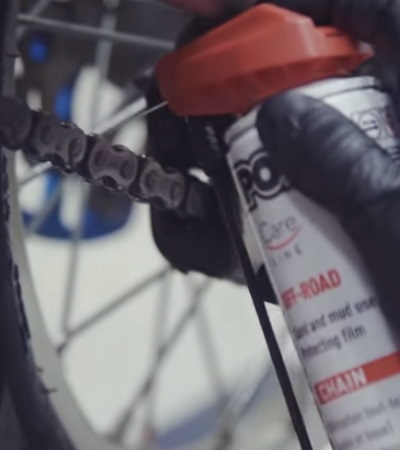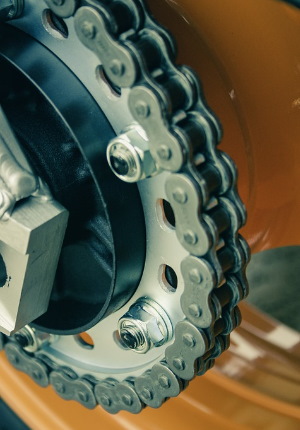
Home > general information > Tips and Guides > Technical guides > Generalists >
How to properly maintain your chain of transmission?
Maintaining your chain is essential to ensure ride comfort, performance and safety. Maintenance-free, the chain wears out quickly. The only way to ensure a long life is with regular maintenance. The film of grease reduces wear. The maintenance of the chain consists of two stages: lubrication (every 2 weeks approximately), cleaning (every 4 lubrication).
Lubrication
Lubrication helps limit friction and combat the formation of rust on components. It is recommended to do this after riding: fat will penetrate better on a slightly warm chain. Be careful, however, not to carry out lubrication with the engine running in order to avoid any risk of accident.
Like all moving mechanical parts, the chain needs lubrication. In addition, on a motorcycle the use of a specific product is absolutely essential to guarantee adhesion and allow practical application.
The lubrication of the chain depends on several factors:
â € ¢ First of all, the weather conditions.
â € ¢ Second, the different uses, the different conditions. Example: if you travel a lot on the motorway, the centrifugal effect caused by epar chain friction is more important. As a result, the chain loses more lubricant and it will have to be lubricated more often. On the contrary, if you usually drive on dirt roads, on dusty areas, you will also need to lubricate the chain periodically. If we talk about motorcyclescross orEnduro, in these cases, it will be necessary to lubricate the chain each time the motorcycle is taken out.
The lubrication will be done every full 2 approximately. If you find that the chain is dirty, clean it. In fact, the sludge is made up of abrasive residues (dust, sand, earth…) which damages the chain kit (pinion, crown, chain).
Cleaning
Place your motorcycle on its center stand or a stand crutch or one motorcycle carrier in order to be able to turn the rear wheel. The engine must be turned off. Otherwise, you will have to ask a friend for a helping hand.
Remove the chain cover, if any. To proceed with cleaning, it is advisable to use a specific degreasing product on a soft micro fiber cloth. You can use the product directly on the chain, being very careful not to get any on the wheel. We also advise you to install boxes under the motorcycle car there is a risk of the product running on the floor.
Do not hesitate to use latex gloves. If you don't have a specific product, you can use deflavored petroleum. Under no circumstances use gasoline or solvent, which will damage the O-rings on your chain.
While the product is working, disassemble the sprocket cover out of the box. Lots of residue and dirt have accumulated there. Remove most of the dirt. Clean the gearbox output gear by spraying the cleaner.
Brush the chain or wipe with a rag, always turning the wheel in the direction of travel to remove stuck grease. The most perfectionists will be able to remove the chain using the quick coupler to have an impeccable result, like a professional. Your chain is now cleaned.
A cleaning every 4 greases seems to be a good ratio.
Chain tension
You must check the tension of your chain before proceeding with the lubrication. The chaîmust neither "too" tense nor "too" relaxed.
In the first place, it is necessary know the right tension of your channel. You will usually find a sticker on the swingarm to indicate the ideal chain tension measurement / distance for your motorcycle. It is also possible, as always, to use the technical book of the motorcycle. The chain must have a beat of 25 to 35mm between the top and the bottom. This fork is wide car it all depends on the motorcycle model.
It is very important to have the same measurement on both sides, so remember to check that everything is aligned correctly. In any case, it is always better if the chain is a little loose than super tight. If your chain is very tight, you will have to relax it otherwise it will break, explode the casing, etc.

Which chain grease to use?
Overall, there are different lubricants for motorcycle chains:
fat paste
In a jar or tube of paste, to be applied by brush, foam applicator or toothbrush.
Advantage: the solid grease allows you to lubricate exactly where you want it, not to spill it next to it, it does not end up on the rear rim and ensures excellent lubrication of the links of the chain.
Disadvantage: the grease sticks and will tend to aggregate the dirt from the road. To be reserved for those who only ride on clean roads and for those who often and carefully clean their chain.
liquid fats
As an aerosol can, to be sprayed as a spray, they are the easiest to use. The ease of application is their main advantage. Medium lubrication, medium adhesion, but few drawbacks.
Comparative advantage: their great fluidity allows them to flow everywhere in the chain, including inside the links, ensuring a longer chain life, provided that they are renewed often lubrication.
Disadvantage: this great fluidity leads to a lot of losses, not only during application, but also during rolling car la force centrifugal is so powerful that it expulse the liquid grease towards the outside at the level of the gearbox output pinion (a component often poorly maintained par bikers) and the rear wheel crown, which covers the rim with grease.
dry lubricants, also called dry greases
In aerosol spray, to spray a very fine film of grease which sticks very little and does not agglomerate dust. Intended primarily for off-road motorcycles that ride in sand, dirt, dust. To renew often.
Conclusion
Maintaining your transmission chain regularly and carefully is crucial to avoid premature wear of the chain kit.
The choice of oil, grease or cleaner depends on the vehicle and the conditions of use.
Before applying any product to your chain, make sure it is safe for the rubber O-rings (or X-rings) found in most of the quality chains on the market.
Learn more about maintaining your chain
Benchmarks
The application of the grease to the chain must be done after a journey that has allowed the expansion of the joints of the chain.ar the action of heat.
Once the chain is hot and expanded, the grease penetrates the links better and also allows the solvents to evaporate more quickly.
Then the grease must be left to rest for about ten hours to ensure its resistance to force centrifugal.
Clearly, lubricate after driving for at least 10 km and let it set overnight.
It is important to apply the lubricant from the inside area. This will prevent grease from settling on the rear wheel, which can be disastrous - risk of falling.
On a chain with O-rings, nowadays generalized, the axles are greased for life (seals inserted between the inner and outer pads retain from the factory fitted a little grease trapped around the axis of each link).
These pins, which join the links of the chain together are the parts most subject to wear, are the most difficult to reach since they are not visible (only their ends appear. s, riveted to the sides of the outer pads).
Be careful, however, this does not exempt from having to lubricate the chain! O-ring chains are not lubricated for life. The seal is only valid for the protected part of the axis.ar the joint, not for the rest of the chain. The other parts are not subject to friction and just require protection against rust.
The lubrication of the secondary transmission chain therefore concerns the pinion, the crown wheel and the rollers (the round parts in the center of each link).
The grease will only be applied on the inside and on the surface of the rollers as well as on the teeth of the pinions (box outlet and crown).
Once the grease has been applied to the entire chain, continue rotating the wheel a few times so that the lubricant is applied to all parts of the chain.









